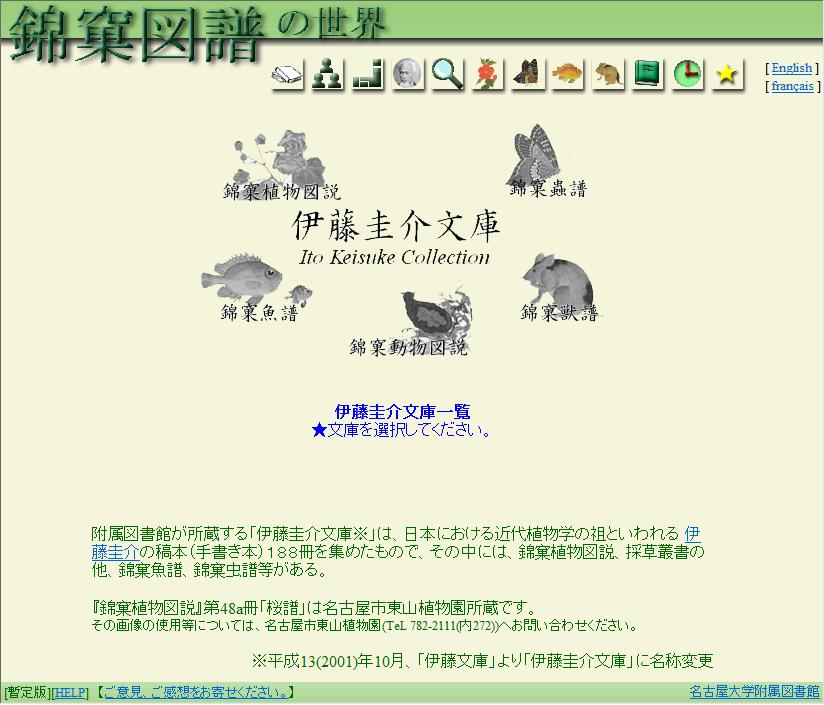 |
The Medical Museum of Nagoya University is located on the fourth floor of the Medical Library. It collects, preserves, and exhibits antique medical books, historical medical instruments, photographs and other items to promote understanding of the history of the Nagoya University School of Medicine in the context of the Tokai district and to look forward to the future of medical science. Parts of the collections can be accessed through the Digital Archive. Registration at the Medical Library counter is required for the actual use of these materials. |
|
2. Herbalism in Owari at the end of Edo Period |
|
|
 |
Herbalism was studied mainly among daimyo hatamoto (feudal lords) in Edo, wealthy merchants in Osaka, and Confucian doctors in Kyoto, but in Owari it centered on feudal retainers and doctors hired by the domain. The reason for this was the existence of the Owari domain's huge herb garden. The director of the garden was MIZUTANI Toyobumi (1779-1833), who wrote "Buppin Shikimei (A Catalogue of the Names of Things)", a desk-side Japanese-Chinese dictionary of animals, plants and minerals for many herbalists at the end of Edo period.
MIZUTANI established the herbalist association "Shohyakusha" through talks with his disciples, OKOCHI Zonshin and ITO Keisuke, and others who shared his interests. Shohyakusha met regularly once a month, its members devoting themselves to the study of materials they had gathered; almost every year the association held a product exposition (pharmaceuticals, medicinal herbs, and natural history), in which it exhibited animal, plant and mineral specimens, drawings, fossils and archaeological artifacts.
Herbalism in Owari spread into the neighboring Mino province and was developed in its own way by Mino Dutch scholars KANDA Ryukei, EMA Katsudo, IINUMA Yokusai and others. It may be said that one characteristic of herbalism in Owari and Mino was that it was supported largely by Dutch scholars.
|
In Bunsei year 9 (1826), SIEBOLD encountered MIZUTANI Toyobumi, OKOCHI Zonshin and ITO Keisuke, members of Shohyakusha, at Owari's Atsuta Shrine on his way to the Edo Shogunate Court. He was amazed to see MIZUTANI's plant sketches, as all of the 102 plants were identified using the names of Linnaean taxonomy. SIEBOLD regarded Shohyakusha's herbal research as fully at a standard which could be receptive to modern botany. When SIEBOLD met with Shobyakusya on his way back from the Shogunate he offered ITO , the youngest member in his mid-twenties, the opportunity to study in Nagasaki.
ITO stayed in Nagasaki from Bunsei year 10 to 11 (1827-1828), and studied natural history under SIEBOLD as a herbalist rather than as a medical scientist. He proved to be a good assistant to SIEBOLD in his natural history fieldwork. The 14-volume book of pressed leaves of Japanese plants which ITO sent to SIEBOLD is today owned by the Netherlands Leiden Museum; there are 15 types of Japanese plant named after ITO Keisuke in their scientific names, including Suzuran (Convallaria keiskei), Iwananten (Leucothoe keiskei), and Inuyomogi (Artemisia keiskeana).
When ITO left Nagasaki, SIEBOLD sent him Carl Peter THUNBERG's "Flora Japonica" as a farewell gift. Returning to his hometown, ITO translated "Flora Japonica", and in Bunsei year 12 (1829) in Nagoya published "Taisei Honzo Meiso (Commentary on Western Plant Names)", a two-volume book in which he added Japanese and Chinese names to the Latin names of Japanese flora. The book is greatly significant in the sense that it introduced Linnaean plant taxonomy, but it could not realize ITO's dream of creating a Japanese plant encyclopedia by combining Linnaean taxonomy with pictures. His dream finally came true when IINUMA Yokusai (1783-1865), a herbalist in Ogaki, published "Somoku Zusetsu (Figures and Descriptions of Plants )" between Ansei 3 and Bunkyu 2 (1856-1862), 30 years later. ITO heartily celebrated its publication and wrote in the preface: "The explanations are detailed and the illustrations elaborate...my regrets over what was left undone for years have been dispelled in this book for the first time." |
|
|
|
|